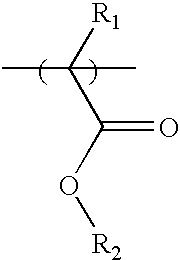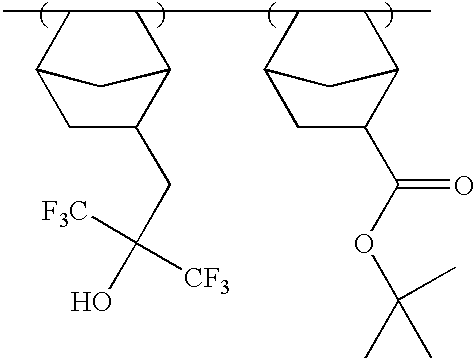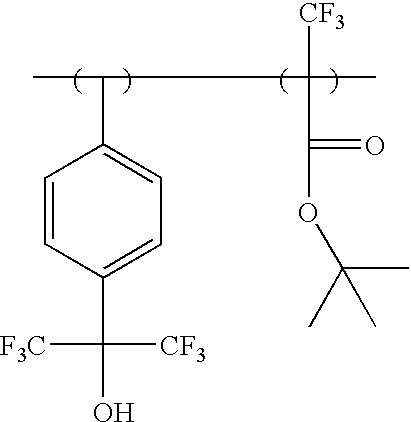Photosensitive polymer having fluorinated ethylene glycol group and chemically amplified resist composition comprising the same
- Summary
- Abstract
- Description
- Claims
- Application Information
AI Technical Summary
Benefits of technology
Problems solved by technology
Method used
Image
Examples
synthesis example 2
Synthesis of Monomer
31 g (0.11 mol) of fluorinated diethylene glycol monomethyl ether and 13 g of triethylamine (TEA) were dissolved in a 500 mL-three-neck flask with 150 mL tetrahydrofuran (THF). 9 g (0.1 mol) of acryloyl chloride in an ice-bath was slowly dropwise added to the resultant solution, followed by reacting at room temperature for about 12 hours.
Thereafter, the same or similar procedure as in Synthesis Example 1 was carried out to give a desired product with a yield of 65%.
synthesis example 3
Synthesis of Monomer
In the formula, R is a hydrogen atom or a methyl group. Fluorinated triethylene glycol monomethyl ether was reacted with acryloyl chloride (R═H) and methacryloyl chloride (R=methyl) in the presence of TEA to give desired products with a yield of 65%, respectively.
example 1
Synthesis of Copolymer
7 g (20 mmol) of the monomer synthesized in Synthesis Example 1, 2.8 g (20 mmol) of t-butyl methacrylate and 0.33 g (5 mol %) of AIBN (azobisisobutyronitrile) were dissolved in 20 g THF. Thereafter, the resultant reaction product was completely purged using a nitrogen gas and polymerized at approximately 65° C. for about 8 hours.
After polymerization, the reaction product was slowly precipitated twice in excess n-hexane and filtered. The filtrate was dried in a vacuum oven maintained at 50° C. for 24 hours to give a desired polymer with a yield of 75%.
The resultant polymer had a weight average molecular weight (Mw) of 18,800 and a polydispersity (Mw / Mn) of 2.0.
PUM
| Property | Measurement | Unit |
|---|---|---|
| Percent by mass | aaaaa | aaaaa |
| Percent by mass | aaaaa | aaaaa |
| Weight | aaaaa | aaaaa |
Abstract
Description
Claims
Application Information
 Login to View More
Login to View More - R&D
- Intellectual Property
- Life Sciences
- Materials
- Tech Scout
- Unparalleled Data Quality
- Higher Quality Content
- 60% Fewer Hallucinations
Browse by: Latest US Patents, China's latest patents, Technical Efficacy Thesaurus, Application Domain, Technology Topic, Popular Technical Reports.
© 2025 PatSnap. All rights reserved.Legal|Privacy policy|Modern Slavery Act Transparency Statement|Sitemap|About US| Contact US: help@patsnap.com



